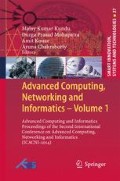Abstract
Recently, research into pathological cytology were intended to put in places of artificial intelligence systems based on the development of new diagnostic technologies and the cell image segmentation. These technologies are not intended to substitute the human expert but to facilitate his task. The objective of this work is to develop a method for diagnosing cancer cervical smears using cervical - vaginal segmented to build our database and a human supervisor and as an automatic tool manage and monitor the execution of the operation of diagnostic and proposing corrective actions if necessary. The Supervisor Smart is manufactured by the technique of neural networks with a success rate of 43.3% followed by the technique of fuzzy logic with a success rate equal to 56.7% and finally to improve this rate we used neuro-fuzzy approach which has a rate which reaches 94%.
Access this chapter
Tax calculation will be finalised at checkout
Purchases are for personal use only
Preview
Unable to display preview. Download preview PDF.
References
Buniet, L.: Traitement automatique de la parole en milieu bruité: étude de modèles connexionnistes statiques et dynamiques. Thèse doctorat. Université Henri Poincaré - Nancy 1. Spécialité informatique, 40–39 (1997)
El Zoghbi, M.: Analyse électromagnétique et outils de modélisation couplés. Application à la conception hybride de composants et modules hyperfréquences. Thèse doctorat. Université de Limoges. Discipline: Electronique des Hautes fréquences et Optoélectronique. Spécialité: Communications Optiques et Microondes, 37 (2008)
Lamine, H.M.: Conception d’un capteur de pression intelligent. Mastère en micro électrique. Option IC Design. Université de Batna: faculté des sciences de l’ingénieur, 18 (2005)
Millot, P.: Systèmes Homme – Machine et Automatique. Université de Valenciennes et du Hainaut – Cambrésis. Laboratoire : LAMIH CNRS. In: Journées Doctorales d’Automatique JDA 1999, Conférence Plénière, Nancy, pp. 23–21 (1999)
Nabli, L.: Surveillance Préventive Conditionnelle Prévisionnelle Indirecte d’une Unité de Filature Textile : Approche par la Qualité. Thèse Doctorat. Discipline: Productique, Automatique et Informatique Industrielle Université des Sciences et Technologies de Lille, 34 – 20 (2000)
Cimuca, G.-O.: Système inertiel de stockage d’énergie associe à des générateurs éoliens. Thèse doctorat. Spécialité: Electrique. Ecole nationale supérieure d’arts et métiers centre de Lille, 162– 163 (2005)
Baghli, L.: Contribution à la commande de la machine asynchrone, utilisation de la logique floue, des réseaux de neurones et des algorithmes génétiques. Thèse doctorat. UFR Sciences et Techniques: STMIA. Université Henri Poincaré, Nancy-I, 16 (1999)
Främling, K.: Les réseaux de neurones comme outils d’aide à la décision floue. Rapport de D.E.A. Spécialité : informatique. Equipe Ingénierie de l’Environnement.Ecole Nationale Supérieure des Mines de Saint-Etienne. Juillet, 12-11 (1992)
Chankonga, T., Heera-Umpon, N., Auephanwiriyakul, S.: Automatic cervical cell segmentation andclassification in Pap smears (2013)
IssacNiwas, S., Palanisamy, P., Sujathan, K., Bengtsson, E.: Analysis of nuclei textures of fine needle aspirated cytology images for breast cancer diagnosis using Complex Daubechies wavelets13 (2012)
Plissiti, M.E., Nikou, C., Charchanti, A.: Combining shape, texture and intensity features for cell nuclei extraction in Pap smear images
Lezoray, O., Cardot, H.: Cooperation of Color Pixel ClassificationSchemes and Color Watershed: A Study for Microscopic Images
Author information
Authors and Affiliations
Corresponding author
Editor information
Editors and Affiliations
Rights and permissions
Copyright information
© 2014 Springer International Publishing Switzerland
About this paper
Cite this paper
Guesmi, L., Boughzala, O., Nabli, L., Bedoui, M.H. (2014). The Use of Artificial Intelligence Tools in the Detection of Cancer Cervix. In: Kumar Kundu, M., Mohapatra, D., Konar, A., Chakraborty, A. (eds) Advanced Computing, Networking and Informatics- Volume 1. Smart Innovation, Systems and Technologies, vol 27. Springer, Cham. https://doi.org/10.1007/978-3-319-07353-8_14
Download citation
DOI: https://doi.org/10.1007/978-3-319-07353-8_14
Publisher Name: Springer, Cham
Print ISBN: 978-3-319-07352-1
Online ISBN: 978-3-319-07353-8
eBook Packages: EngineeringEngineering (R0)

